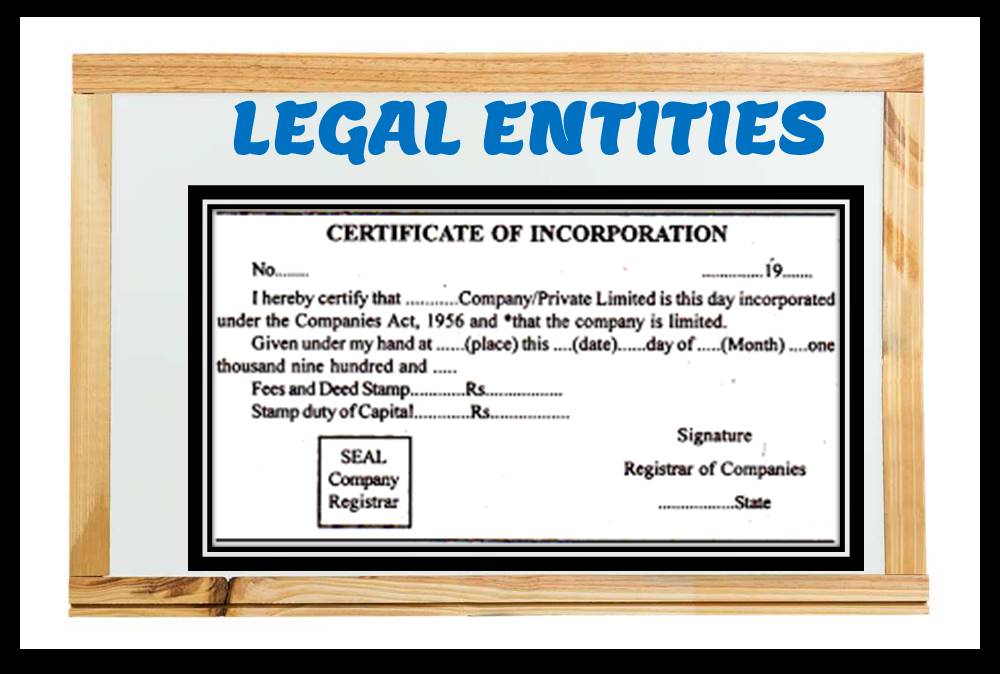- Home
- Business Processes
- Industry Knowledge
- Aerospace Industry
- Automotive Industry
- Banking Domain
- BFSI Industry
- Consumer/ FMCG Industry
- Chemicals Industry
- Engineering & Construction
- Energy Industry
- Education Domain
- Finance Domain
- Hospitality Domain
- Healthcare Industry
- Insurance Domain
- Retail Industry
- Travel and Tourism Domain
- Telecom Industry
- Leadership Skills
- eLearning
- Home
- Business Processes
- General Ledger (Record to Report)
- Concept of Legal Entity
Concept of Legal Entity
A legal entity is an artificial person having separate legal standing in the eyes of law. A Legal entity represents a legal company for which you prepare fiscal or tax reports. A legal entity is any company or organization that has legal rights and responsibilities, including tax filings.
One of the most frequently used terms in the world of compliance and governance is that of the legal entity. But what is the meaning of a legal entity, and why is it so important for finance, compliance, legal and operational professional?
As explained before, A business is entitled enter into commercial transactions due to its charter in the legal system. Commercial groups exist through corporate law. Units in the legal structure of a group are individual companies that share common ownership and control. In a public group, a company is owned by the public through shares sold on a stock market. In a private group, they are held by a privately held holding company. In other organizations, the legal entities are partnerships, funds, or government agencies. A legally recognized entity can own and trade assets and employ people; while an entity without legal recognition cannot. When granted these privileges, legal entities are also assigned responsibilities to account for themselves to the public (statutory reporting and external reporting), comply with legislation and regulations, and pay income or transaction taxes.
What Is a Legal Entity?
A legal entity is an artificial person having separate legal standing in the eyes of law. A Legal entity represents a legal company for which you prepare fiscal or tax reports. A legal entity is any company or organization that has legal rights and responsibilities, including tax filings. It is a business that can enter into contracts either as a vendor or a supplier and can sue or be sued in a court of law. A legal entity can enter into contracts and assume the obligations of those contracts, can borrow and pay debts, can file suits and be named by other parties in suits, and can be held to account for the results of those lawsuits.
Features of Legal Entities
- Legal Entity is also known as GRE - Government Reporting Entity. Some of the attributes associated with legal entity are:
Structure
- A Legal entity is identified through the registration with Legal Authority.
- You assign tax identifiers and other Legal entity information to legal entity
- Legal Entity possesses separate existence for tax purposes. Legal Entities pay the taxes and therefore need tax registrations.
- Legal entities such as parent companies own or control subsidiaries. A large corporation can own many legal entities as its subsidiaries.
Rights & Obligations
- A legal entity has legal capacity to enter into agreements or contracts, assume obligations, incur and pay debts, sue and be sued in its own right, and to be held responsible for its actions.
- Trade between Legal Entities belonging to same corporate is intercompany and must be supported by adequate legal documentation.
- Legal Entities own the money and bank accounts
Compliance & Accounting
- Legal Entities comply with whatever needs compliance – The “Legal” in word “Legal Entity”. This includes recording of all relevant transactions and generating all supporting documents required for financial statements.
- Legal Entities file the accounts and take care of accounting. Legal Entity is the organizational unit for Financial Accounting for which a complete self-contained set of accounts needs to be drawn up for purposes of external reporting.
- Accounting Books must balance at Legal Entity level. This is an entity for which you prepare a trial balance.
Summary
Legal entities are structured in a way that allows for a greater degree of protection for strictly personal assets from lawsuits and regulatory penalties. Each type of entity provides a different set of protections and tax burdens. Legal entity codes are not standardized, despite the globalized economic world in which we live, due to the laws and regulations that govern legal entities fluctuate drastically across jurisdictions.
Related Links
You May Also Like
-
Period End Accruals, Receipt Accruals, Paid Time-Off Accruals, AP Accruals, Revenue Based Cost Accruals, Perpetual Accruals, Inventory Accruals, Accruals Write Off, PO Receipt Accrual, Cost Accrual, etc. are some of the most complex and generally misconstrued terms in the context of general ledger accounting. In this article, we will explore what is the concept of accrual and how it impacts general ledger accounting.
-
Legal Structures in Businesses
Businesses not only vary in size and industry but also in their ownership. Most businesses evolve from being owned by just one person to a small group of people and eventually being managed by a large numbers of shareholders. Different ownership structures overlap with different legal forms that a business can take. A business’s legal and ownership structure determines many of its legal responsibilities.
-
Functional Organizational Structures
A functional organizational structure is a structure that consists of activities such as coordination, supervision and task allocation. The organizational structure determines how the organization performs or operates. The term organizational structure refers to how the people in an organization are grouped and to whom they report.
-
For any company that has a large number of transactions, putting all the details in the general ledger is not feasible. Hence it needs to be supported by one or more subsidiary ledgers that provide details for accounts in the general ledger. Understand the concept of the subsidiary ledgers and control accounts.
-
What Is a General Ledger? General Ledger (also known in accounting as the GL or the Nominal Ledger) is at the heart of any accounting system. A general ledger is the master set of accounts that summarize all transactions occurring within an entity. Ledger is the skillful grouping and presentation of the Journal entries. Learn the accounting fundamentals, general ledger process, and general ledger flow.
-
Explore the concept of journal reversals and understand the business scenarios in which users may need to reverse the accounting entries that have been already entered into the system. Understand the common sources of errors resulting in the reversal of entries and learn how to correct them. Discuss the reversal of adjustment entries and the reversal functionalities in ERPs.
-
After reading this article the learner should be able to understand the meaning of intercompany and different types of intercompany transactions that can occur. Understand why intercompany transactions are addressed when preparing consolidated financial statements, differentiate between upstream and downstream intercompany transactions, and understand the concept of intercompany reconciliations.
-
In this article, we will explain the general Ledger journal processing flow from entering journals to running the final financial reports. Understand the generic general ledger process flow as it happens in automated ERP systems. The accounting cycle explains the flow of converting raw accounting data to financial information whereas general ledger process flow explains how journals flow in the system.
-
Legal Structures for Multinational Companies
A multinational company generally has offices and/or factories in different countries and a centralized head office where they coordinate global management. A multinational company (MNC)is a corporate organization that owns or controls the production of goods or services in at least one country other than its home country.
-
As the business grows, the company may want to transition to a branch structure as branches are allowed to conduct a much broader range of activity than representative offices. Branches can buy and sell goods, sign contracts, build things, render services, and generally everything that a regular business can do. A company expands its business by opening up its branch offices in various parts of the country as well as in other countries.
Explore Our Free Training Articles or
Sign Up to Start With Our eLearning Courses

About Us
Learning
© 2023 TechnoFunc, All Rights Reserved











